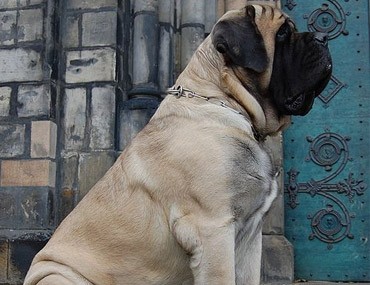Background
The history of the Mastiff (also known as the English Mastiff or Old English Mastiff) is extensive. They are similar in size and build to dogs that were carved into figurines as far back as 6th century BC. Although we can only speculate on the breeds of that time, we can be sure that Caesar fought against mastiffs in 55 BC when he invaded Britain. Apparently, the dogs were impressive in battle, showing both great loyalty and strength.
Mastiffs were still used as war dogs as late as the 16th century. During that era they were also used to patrol estates. Sir Piers Legh of Lyme Hall had perhaps the most incredible mastiff story of the middle ages: After he fell injured in battle it’s said that his dog kept him safe and protected until he could be removed from the field. The dog was later returned to his estate to help him heal.
Modern Mastiffs can be credited to England where the breed’s temperament began a radical transformation. In 1835 Dog fighting was outlawed in England. After that, the mastiff breed was slowly repurposed from a fighter into a companion.
Food shortages during World War I and World War II almost put an end to the breed altogether, fortunately they survived and have gained popularity ever since the 1950’s. They’ve come a long way from the battlefield and are now known by the affectionate nickname “gentle giants.”
Sizing Up
- Weight: 120 – 250 pounds
- Height : 27.5- 30 inches

- Coat: Short, close-lying, fine, smooth
- Color: Apricot, brindle, fawn
- Life Expectancy: 7+
What are they like?
In spite of their massive size Mastiffs are very sweet and loving. They would be satisfied to stay at your feet and you won’t need to shower them with attention all the time. That said, they would be very happy to have any attention you’re willing to give. They’ll certainly lay right next to you if they can, even sleep in the bed, assuming you have a very large bed.
They are territorial in a sense, meaning that they will protect the family, if they feel they’re a part of it. They don’t like to be left alone outside and if you do so they won’t feel any strong obligation to defend your yard. Failing to socialize them properly might also lead to aggression problems and property destruction.
All dogs are a commitment but the Mastiff is especially sensitive to changes in its life. Don’t get one unless you’re sure you can handle it. They can be devastated by losing a family.
With a large dog comes many of the health concerns you might expect. The extra weight means you must maintain a regular exercise regimen. The mastiff is particularly susceptible to hip dysplasia, gastric torsion, obesity, osteosarcoma and cystinuria.
Right breed for you?
- Space: The mastiff is a very large dog, it’s best if they have a lot of room. Also consider that they’re hard to carry, making apartment stairs difficult if they’re ever immobilized.
- Guard: The breed still makes for a very strong presence in your home. They have not lost the instincts that have always made them great at repelling intruders.
- Children: With proper socializing they are great around kids, but they’re size still makes accidental injury possible.
If you have any questions or concerns, you should always visit or call your veterinarian – they are your best resource to ensure the health and well-being of your pets.
